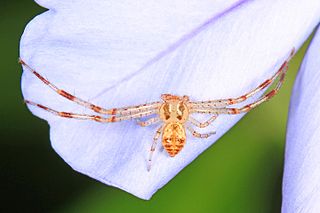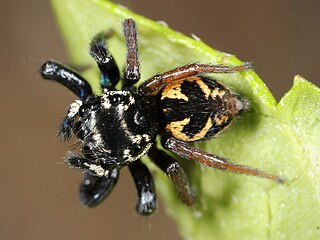
The Thomisidae are a family of spiders, including about 175 genera and over 2,100 species. The common name crab spider is often linked to species in this family, but is also applied loosely to many other families of spiders. Many members of this family are also known as flower spiders or flower crab spiders.

Jumping spiders or the Salticidae are a family of spiders. As of 2019, it contained over 600 described genera and over 6000 described species, making it the largest family of spiders at 13% of all species. Jumping spiders have some of the best vision among arthropods and use it in courtship, hunting, and navigation. Although they normally move unobtrusively and fairly slowly, most species are capable of very agile jumps, notably when hunting, but sometimes in response to sudden threats or crossing long gaps. Both their book lungs and tracheal system are well-developed, and they use both systems. Jumping spiders are generally recognized by their eye pattern. All jumping spiders have four pairs of eyes, with the anterior median pair being particularly large.

Misumenops is a common genus of crab spider with more than 50 described species.

Corythalia is a genus of jumping spiders that was first described by Carl Ludwig Koch in 1850.

Diaea dorsata is one of the smaller crab spiders, with a palearctic distribution. Females can grow up to 6 mm, males up to 4 mm. Prosoma and legs are green, the opisthosoma is yellowish with a brown mark.

Diaea is a genus of crab spiders first described by Tamerlan Thorell in 1869. Most species are found in specific locations except for D. livens, which occurs both in the United States and D. dorsata, which has a palearctic distribution. Adults are 5 millimetres (0.20 in) to 7 millimetres (0.28 in) and tend to hide in and around vegetation, especially flowers, where their color allows them to blend in to their surroundings.
Exiliboa is a monotypic genus created for the non-venomous dwarf boa species, Exiliboa placata, which is endemic to southern Mexico. No subspecies are currently recognized.

Tharrhalea evanida, synonym Diaea evanida, also called the pink flower spider, is a species of spider in the family Thomisidae. It is found in Australia and in New Guinea.

Spiders are air-breathing arthropods that have eight legs, chelicerae with fangs generally able to inject venom, and spinnerets that extrude silk. They are the largest order of arachnids and rank seventh in total species diversity among all orders of organisms. Spiders are found worldwide on every continent except for Antarctica, and have become established in nearly every habitat with the exceptions of air and sea colonization. As of July 2019, at least 48,200 spider species, and 120 families have been recorded by taxonomists. However, there has been dissension within the scientific community as to how all these families should be classified, as evidenced by the over 20 different classifications that have been proposed since 1900.
Acleris placata is a species of moth of the family Tortricidae. It is found in India (Assam), Taiwan and Japan.

Alireza Zamani is an Iranian arachnologist and taxonomist.
Cetratus is a genus of South Pacific crab spiders that was first described by Władysław Kulczyński in 1911.

Diaea livens is a species of crab spider in the family Thomisidae. It is found in Southern and Central Europe, Turkey, Caucasus, Iran, and has been introduced into the United States.
Bomis is a genus of crab spiders that was first described by Ludwig Carl Christian Koch in 1874.

Diaea ambara is a species of crab spider that is endemic to New Zealand.

Australomisidia cruentata, one of the crab spiders, is a small spider found in Australia. The body length of the female is up to 5 mm, the male 3 mm. An ambush predator, often seen on flowers in the Pultenaea group of egg and bacon plants, belonging to the pea family. The egg sac is also laid on the flowers. Petals being fastened with silk in a chamber. The spider stays with the eggs, probably still hunting from the entrance of the retreat, with the egg sac nearby. Prey is small flying insects. The genus Australomisidia was created in 2014, the word being a combination of Australia and Thomisidae, the crab spiders.
The peaceful miner bee is a species of miner bee in the family Andrenidae. It is found in North America.











